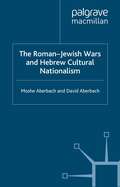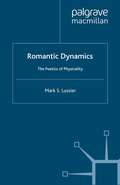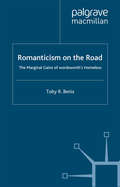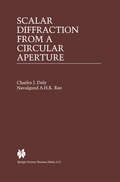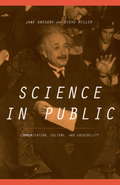- Table View
- List View
Rolling Contact Phenomena (CISM International Centre for Mechanical Sciences #411)
by Bo Jacobson Joost J. KalkerPreface.- Rolling Contact Phenomena - Linear Elasticity.- Finite Element Methods for Rolling Contact.- Plastic Deformation in Rolling Contact.- Non-Steady State Rolling Contact and Corrugations.- Modelling of Tyre Force and Moment Generation.- Rolling Noise.- Lubrication
The Roman-Jewish Wars and Hebrew Cultural Nationalism, 66-2000 CE
by D. AberbachIn this controversial book, the authors show how the Roman-Jewish wars were precipitated partly by Jewish demographic and religious expansion and by conflict with the Greeks and their culture. They argue that the trauma and humiliation of defeat, stimulated Jewish cultural growth, particularly in Hebrew, during and after the wars. This culture was an implicit rejection of Graeco-Roman civilization and values in favour of a more exclusivist religious-cultural nationalism. This form of nationalism, though unique in the ancient world, anticipates more recent cultural-national movements of defeated peoples.
Romansy 13: Theory and Practice of Robots and Manipulators (CISM International Centre for Mechanical Sciences #422)
by Adam Morecki Giovanni Bianchi Cezary RzymkowskiCharacterisation: this volume presents the latest contribution to the theory and practice of modern robotics given by the world recognised scientists from Australia, Canada, Europe, Japan and USA.
Romantic Dynamics: The Poetics of Physicality (Romanticism in Perspective:Texts, Cultures, Histories)
by M. LussierRomantic Dynamics creatively collides English poetry with a wide range of exotic concepts associated with the 'new physics' of relativity and quantum to uncover their shared concerns for indeterminacy, uncertainty, relativity, and complexity in a chaotic universe. This interdisciplinary work traces the elaboration of dynamical models of cosmos and consciousness in works by Blake, Byron, Coleridge, the Shelleys and Wordsworth, finding in those works an exploration of the interpenetration of psyche and phenomena. This model, the author argues, establishes a new metaphoric terrain liberated from the classical mechanics of Newtonian thought and more easily traversed with models articulated by Bohr, Einstein and Hawking.
Romantic Turbulence: Chaos, Ecology, and American Space
by NA NAEric Wilson reveals a neglected yet powerful current in several major Romantic figures: the affirmation of - not escape from - turbulence. Romantic Turbulence unearths the chaotic undercurrents of European Romanticism found in Goethe s science and Schelling s philosophy, and demonstrates how these tendencies agitate the texts of Emerson, Fuller, Melville, Thoreau, and Whitman. These writers see the universe not as a reflection of transcendent harmony or a system of predictable laws but rather as a convergence of chaos and order, a polarized field. Detailing this undulatory cosmos, Wilson shows how these American Romantics participate in its unsettling rhythms by practicing an ecological poetics, translating the energies of their habitat into living compositions.
Romanticism on the Road: The Marginal Gains of Wordsworth's Homeless (Romanticism in Perspective:Texts, Cultures, Histories)
by T. BenisRomanticism on the Road challenges critical orthodoxy by arguing that Wordsworth rejected the political dogmas of his age. Refusing to ally with either radicals or conservatives after the French Revolution, the poet seizes on vagrants to attack the binary thinking dominating public affairs and to question the value of the Georgian domestic ideal. Drawing on current and historical discussions of homelessness, the study offers a cultural history of vagrancy and explains why Wordsworth chose the homeless to bear his message.
Root Hairs: Cell and Molecular Biology
by R. W. Ridge A. M. C. EmonsRoot hairs are tip-growing cells that originate from epidennal cells called trichoblasts. Their role may be simply thought of as extending the surface area of the root to facilitate absorption of nutrients and water. However, as you will see in this book, the root hair is far more than that. To an increasingly larger number of plant biologists, the root hair is a model cell. It grows in much the same way as a pollen tube, by sending vast numbers of vesicles containing cell wall precursors to a rounded apical dome, the tip. Once the trichoblast becomes committed to root hair fonnation, it no longer divides. The root hair cell has a migrating nucleus and a complex cytoskeleton. It has a varied cell wall. It is easy to observe through differential interference contrast microscopy because there are no other cells around it to disturb the image. Cytoplasmic streaming is exceptionally clear, and amyloplasts and even mitochondria and endoplasmic reticulum can be seen without reporter labelling in some species. Root hair mutants are easy to distinguish and catalogue. Plant honnones are involved in their growth and development. It is thus an almost ideal plant cell for experimental manipulation and observation. The root hair is also involved in interactions with soil microbes, as you will learn from later chapters of the book.
Root Methods: A Handbook
by A. L. Smit A. G. Bengough C. Engels M. Van Noordwijk S. Pellerin S. C. Van De GeijnA comprehensive review of all modern methods for plant root research, both in the field and in the laboratory. It covers the effects of environmental interactions with root growth and function, focussing in particular on the assessment of root distribution and dynamics. It also describes and discusses the processing of root observations, analysis and modelling of root growth and architecture, root-image analysis, computer-assisted tomography and magnetic resonance imaging. Furthermore, a survey of the application of isotope techniques in root physiology is given.
Ross Sea Ecology: Italiantartide Expeditions (1987–1995)
by F. M. Faranda L. Guglielmo Adrianna IanoraThe Antarctic represents the last of the world's still unexplored continents. Since 1985, Italy has sent 10 expeditions to this region, three of those have been exclusively devoted to research on the marine ecology of the Ross Sea region. This volume presents a global picture of this research. It includes contributions on water mass characteristics, particulate organic matter and nutrient utilization, and physiological aspects of primary production. Further topics are zooplankton, krill and top predator interactions in relation to physical and biological parameters, ecological features of coastal fish communities and the spatio-temporal variability of benthic biocenoses.
Russia’s Agro-Food Sector: Towards Truly Functioning Markets
by Peter Wehrheim Klaus Frohberg Eugenia Serova Joachim Von BraunSame-Sex Love in India: Readings from Literature and History
by NA NALambda literary award finalist, Same-Sex Love in India presents a stunning array of writings on same-sex love from over 2000 years of Indian literature. Translated from more than a dozen languages and drawn from Hindu, Buddhist, Muslim, and modern fictional traditions, these writings testify to the presence of same-sex love in various forms since ancient times, without overt persecution. This collection defies both stereotypes of Indian culture and Foucault's definition of homosexuality as a 19th-century invention, uncovering instead complex discourses of Indian homosexuality, rich metaphorical traditions to represent it, and the use of names and terms as early as medieval times to distinguish same-sex from cross-sex love. An eminent group of scholars have translated these writings for the first time or have re-translated well-known texts to correctly make evident previously underplayed homoerotic content. Selections range from religious books, legal and erotic treatises, story cycles, medieval histories and biographies, modern novels, short stories, letters, memoirs, plays and poems. From the Rigveda to Vikram Seth, this anthology will become a staple in courses on gender and queer studies, Asian studies, and world literature.
Sands, Powders, and Grains: An Introduction to the Physics of Granular Materials (Partially Ordered Systems)
by Jacques DuranThis introductory text develops the fundamental physics of the behavior of granular materials. It covers the basic properties of flow, friction, and fluidization of uniform granular materials; discusses mixing and segregation of heterogeneous materials (the famous "brazil-nut problem"); and concludes with an introduction to numerical models. The presentation begins with simple experiments and uses their results to build concepts and theorems about materials whose behavior is often quite counter-intuitive; presenting in a unified way the background needed to understand current work in the field. Developed for students at the University of Paris, the text will be suitable for advanced undergraduates and beginning graduates; while also being of interest to researchers and engineers just entering the field.
Saponins in Food, Feedstuffs and Medicinal Plants (Proceedings of the Phytochemical Society of Europe #45)
by Wieslaw OleszekSaponins are glycosides of triterpenes, steroids or steroidal alkaloids. They can be found in plants and marine organisms. Very diverse biological activities are ascribed to saponins and they play important roles in food, animal feedstuffs, and pharmaceutical properties. This volume provides a selection of recent work on saponins presented at a symposium in Pulawy, Poland, in 1999. Many different aspects are treated: analysis, separation, biological activities, relevant use in human and animal nutrition, and ecological significance. This book will be of use to researchers both in universities and industry.
Satellite Orbits: Models, Methods and Applications
by Oliver Montenbruck Eberhard GillThis modern presentation guides readers through the theory and practice of satellite orbit prediction and determination. Starting from the basic principles of orbital mechanics, it covers elaborate force models as well as precise methods of satellite tracking. The accompanying CD-ROM includes source code in C++ and relevant data files for applications. The result is a powerful and unique spaceflight dynamics library, which allows users to easily create software extensions. An extensive collection of frequently updated Internet resources is provided through WWW hyperlinks.
Scalar Diffraction from a Circular Aperture (The Springer International Series in Engineering and Computer Science #549)
by Charles J. Daly Navalgund A.H.K. RaoScalar diffraction from a circular aperture is a ubiquitous problem that arises in a variety of disciplines, such as optics (lenses), acoustics (speakers), electromagnetics (dish antennas), and ultrasonics (piston transducers). The problem endures despite centuries of research because each new generation of researchers rediscovers it and adds some novel insight or new result to the existing literature. Scalar Diffraction from a Circular Aperture promises a few new results and several novel insights, particularly with regard to spatial averaging. Although the text emphasizes ultrasonic diffraction, the results and insights developed are general and may be applied to the many practical problems involving scalar diffraction from a circular aperture. Included are novel insights on mirror-image diffraction, autoconvolution diffraction, and coherent and incoherent averaging. Examples from ultrasonic imaging, a coherent imaging modality, are used to develop a fairly general theory that connects over a century of research on scalar diffraction from a circular aperture. The material is based on a synthesis of mathematics, physical optics, linear systems theory, and scalar diffraction theory. Thus, engineers, scientists, mathematicians, and students working in optics, acoustics, antenna design, biomedical engineering, non-destructive testing, and astronomy will find Scalar Diffraction from a Circular Aperture interesting, provocative, and useful.
Scheduling: Control-Based Theory and Polynomial-Time Algorithms (Applied Optimization #43)
by K. Kogan E. KhmelnitskyThis book presents a first attempt to systematically collect, classify and solve various continuous-time scheduling problems. The classes of problems distinguish scheduling by the number of machines and products, production constraints and performance measures. Although such classes are usually considered to be a prerogative of only combinatorial scheduling literature, the scheduling methodology suggested in this book is based on two mathematical tools - optimal control and combinatorics. Generally considered as belonging to two totally different areas of research and application, these seemingly irreconcilable tools can be integrated in a unique solution approach with the advantages of both. This new approach provides the possibility of developing effective polynomial-time algorithms to solve the generic scheduling problems. This book is aimed at a student audience - final year undergraduates as well as master and Ph.D. students, primarily in Operations Research, Management, Industrial Engineering and Control Systems. Indeed, some of the material in the book has formed part of the content of undergraduate and graduate courses taught at the Industrial Engineering Department of Tel-Aviv University, the Logistics Department of Bar-Ilan University and the Technology Management Department of Rolon Center for Technological Education, Israel. The book is also useful for practicing engineers interested in planning, scheduling and optimization methods. Since the book addresses the theory and design of computer-based scheduling algorithms, applied mathematicians and computer software specialists engaged in developing scheduling software for industrial engineering and management problems will find that the methods developed here can be embedded very efficiently in large applications.
Schopenhauer’s Broken World-View: Colours and Ethics between Kant and Goethe (Science and Philosophy #10)
by P.F. LauxtermannSchopenhauer's philosophy, at first sight so beautifully rounded, upon analysis reveals itself as the secret arena of two conflicting world-views. The present analysis considers the conflict by confronting Schopenhauer as a `disciple-of-sorts of Kant' with Schopenhauer as `Goethe's one-time collaborator on the theory of colour'. Here the two meet over profound issues which the Scientific Revolution of the 17th century has ineluctably put before us: what is the right level at which to apprehend nature; what is the proper foundation for a consistent ethics; how (if at all) to arrive at a unified conception of a world broken by modern science? In this deeply-delving, lucidly written, humane and erudite study, the history of philosophical currents is blended with history of science, with history of ideas generally, and (to elucidate relevant portions of Schopenhauer's biography and intellectual and social environment) with German history too. The analysis, while benefiting from the scholarly literature, is grounded primarily in original research among the collected works of Schopenhauer, Kant and Goethe, considered in all their philosophical, scientific, and literary variety.
Science 3-13: The Past, The Present and Possible Futures
by Paul Warwick Rachel Sparks LinfieldWhich factors have been influential in developing science teaching and learning for the three to thirteen age group in the last twenty years? How might these factors have an impact on the future direction of science teaching and learning for this age range into the 21st century? How can teachers cope with the changes?Science 3-13 explores some of the historical antecedents of the current position of science in the lives of younger children. It covers the various influences, both from within and outside the teaching profession, that have shaped the current science curriculum. Current practice is examined and, on this basis, speculations are made about the future position and direction of this important subject.The contributors each cover a particular aspect of science for the 3-13 age range but common themes emerge such as the influence of government intentions, particularly through the development of the National Curriculum. The role of research groups and the impact of ICT on the teaching profession as to what is important to teach and how science and science teaching should be viewed within society are shown to be important factors in the mix that contributes to change.This book forms part of a series of key texts which focus on a range of topics related to primary education and schooling. Each book in the Primary Directions Series will review the past, analyse current issues, suggest coping strategies for practitioners and speculate on the future.
Science 3-13: The Past, The Present and Possible Futures
by Rachel Sparks Linfield Paul WarwickWhich factors have been influential in developing science teaching and learning for the three to thirteen age group in the last twenty years? How might these factors have an impact on the future direction of science teaching and learning for this age range into the 21st century? How can teachers cope with the changes?Science 3-13 explores some of the historical antecedents of the current position of science in the lives of younger children. It covers the various influences, both from within and outside the teaching profession, that have shaped the current science curriculum. Current practice is examined and, on this basis, speculations are made about the future position and direction of this important subject.The contributors each cover a particular aspect of science for the 3-13 age range but common themes emerge such as the influence of government intentions, particularly through the development of the National Curriculum. The role of research groups and the impact of ICT on the teaching profession as to what is important to teach and how science and science teaching should be viewed within society are shown to be important factors in the mix that contributes to change.This book forms part of a series of key texts which focus on a range of topics related to primary education and schooling. Each book in the Primary Directions Series will review the past, analyse current issues, suggest coping strategies for practitioners and speculate on the future.
Science and Art Symposium 2000: 3rd International Conference on Flow Interaction of Science and Art with Exhibition/Lectures on Interaction of Science & Art, 28.2 — 3.3 2000 at the ETH Zurich
by A. Gyr Petros D. Koumoutsakos U. BurrSome words about SCART 2000. SCART stands for science and art. SCART meetings are organized in a loose time sequence by an international group of scientists, most of them fluid-dynamicists. The first meeting was held in Hong-Kong, the second one in Berlin, and the third, and latest, one in Zurich. SCART meetings include a scientific conference and a number of art events. The intention is to restart a dialogue between scientists and artists which was so productive in the past. To achieve this goal several lectures given by scientists at the conference are intended for a broader public. In the proceedings they are denoted as SCART lectures. The artists in tum address the main theme of the conference with their contributions. The lectures at SCART 2000 covered the entire field of fluiddynamics, from laminar flows in biological systems to astrophysical events, such as the explosion of a neutron star. The main exhibition by Dutch and Swiss artists showed video and related art under the title 'Walking on Air'. Experimental music was performed in two concerts.
Science Fiction, Critical Frontiers
by NA NAScience fiction has recently been identified as providing the narrative paradigm for postmodernity. This volume of essays combines theoretical discussions of the nature of science fiction, with specific studies of utopian and dystopian narratives. Alongside of this, the essays here address feminist and African American issues, the envisioning of radical alternative realities and futures, cyborgs, cyberpunk and cyber-space, age and aging, hybridity and monstrosity, and contemporary society and the postmodern condition.
Science In Public: Communication, Culture, And Credibility
by Jane Gregory Steven MillerDoes the general public need to understand science? And if so, is it scientists' responsibility to communicate? Critics have argued that, despite the huge strides made in technology, we live in a "scientifically illiterate" society--one that thinks about the world and makes important decisions without taking scientific knowledge into account. But is the solution to this "illiteracy" to deluge the layman with scientific information? Or does science news need to be focused around specific issues and organized into stories that are meaningful and relevant to people's lives? In this unprecedented, comprehensive look at a new field, Jane Gregory and Steve Miller point the way to a more effective public understanding of science in the years ahead.
Science in Translation: Movements of Knowledge through Cultures and Time
by Scott L. MontgomeryIn this innovative work, Scott L. Montgomery explores the diverse roles that translation has played in the development of science from antiquity to the present—from the Arabic translations of Greek and Latin texts whose reintroduction to Europe was crucial to the Renaissance, to the origin and evolution of modern science in Japan. "[A] book of great richness, as much for its examples as for its ideas, which keenly illustrate the development of knowledge across languages and epochs. It is a book to read and reread. Its subject is important; it is ours, it is our history." -André Clas, Meta: Journal des Traducteurs "[T]his book . . . seems to stand alone on the shelf. A good thing, therefore, that it is so full of good things, both in the content and the prose." —William R. Everdell, MAA Online "[A]n impressive work. . . . By reminding us of the role of diverse cultures in the elevation of science within a particular nation or civilization, the book makes a substantial contribution to the postmodern worldview that emphasizes multiculturalism." —Choice
The Science of Paintings
by W.Stanley Jr. Taft James W. MayerThe physics and materials science behind paintings: the pigments, binders, canvas, and varnish that go into making a painting appear the way it does. The text discusses the physical principles behind the colors seen and how these change with illumination, the various types of paint and binders used in both old and modern paintings, and the optics and microscopic structure of paint films. Chapters on dating, binders, and dendochronology have been contributed by experts in the respective fields.
Science Teacher Education: An International Perspective (Contemporary Trends and Issues in Science Education #10)
by Sandra K. AbellAnalysis of past developments in teacher education in Pakistan has shown that substantial progress has been made in this field. It has, however, been pointed out that education of science teachers still needs much improvement. At the present, there is an emergent need to meet the shortage of qualified science teachers and at the same time to bring qualitative improvements in the courses offered in teacher education institutions. First, we recommend that the 1-year duration of teacher preparation is grossly inadequate for all teaching courses, and should be lengthened, and the qualifications for entrance be increased. We believe that teaching must be made a graduate profession. For example, the basic qualification of primary school teachers for admission to teacher education institution should be increased. We recommend that PTC should be made a 12 + 2 year program. Similarly, CT, 12 + 3; B. Ed. , 14 + 2; B. S. Ed. , 12 + 4; M. A. Ed. , 14 + 3; and M. Ed. one year after B. Ed. or B. S. Ed. Secondly, we think the quality of instruction in teacher preparation programs should be improved. Most teachers in the teacher preparation institutions use the lecture method most of the time. Prospective teachers behave like passive listeners to their teachers. They do not participate in the teaching/ learning process. Some instructors even dictate their notes to the preservice teachers. When the teachers join schools, they behave the same way.

